How to Choose Your Cruise: South America
South America was born a winner. Start with its dazzling array of record-breaking natural wonders: the greatest rainforest, largest river, longest mountain range, highest waterfall, longest beach, largest wetland and driest nonpolar desert on the planet. Add in ice-blue glaciers and misty cloud forests, towering volcanoes and sparkling fjords, red-rock canyons and endless sprawling pampas. The result is a variety of landscapes that is hard to beat.
But South America’s diversity doesn’t end with its scenery. As head turning as it is, I’ve always been a sucker for its tantalizing indigenous markets and sultry tango moves, its cobblestoned colonial towns and saucy samba beats, its enigmatic ancient ruins and vibrant modern cities. I’ve loved sipping a full-bodied Colombian coffee at a café wrapped in Cartagena’s colonial splendor. Or shopping for the finest alpaca woolens, then scrambling over a centuries-old temple ruin in the heart of Lima. Or savoring ocean-fresh ceviche overlooking the sea in bohemian Valparaíso, Chile, and dancing the tango in a dark, intimate milonga and enjoying a classical opera in the iconic Colon Theatre in Buenos Aires. Being astonished by an impromptu capoeira martial art performance on the street in Salvador, Brazil.
Indeed, the continent is a rich tapestry of the ancient, colonial and modern world, woven with the multi-hued strands of indigenous, African and European cultures. Pre-Columbian remnants of advanced civilizations vie with gilded churches and ornate mansions of the colonial era — sometimes side by side. You can mingle with traditionally clad residents of adobe pueblos and stylish trend setters in glass-encased high-rises — sometimes on the same day. You can haggle over handmade crafts at old-time markets and shop for cutting-edge fashions — all in the same city.

Equally hybridized, music lights up this part of the world. I love the way it forms a constant refrain, spilling out of doorways and windows, radiating from cozy clubs and bars, and blaring joyfully from outdoor stages and street festivals. Let your hips follow the driving rhythms of Colombian cumbia, of Brazil’s sensual samba and fast-paced forró, or of Guyanese steel-pan drumming. Sway to a stylized Argentine tango, a soulful Ecuadorian pasillo or the folk music of Peru, so haunting with its Andean flutes and panpipes.
Just consider the food, a mouth-watering fusion of culture, environment and history, dished up by sit-down eateries and street vendors alike. I love snacking on Peruvian grilled anticuchos and fresh-from-the-sea ceviche. Or savoring a thick potato-based ajiaco soup or a cazuela de mariscos fish stew in Colombia. Or tucking into an Argentine parrilla of grilled meats slathered with classic chimichurri garlic-parsley sauce, feasting on a Brazilian feijoada bean-and-meat stew topped with crumbly manioc-flour farofa, and grabbing a quick chivito sandwich, Uruguay’s national dish. Tasting an empanada turnover filled with meat or cheese throughout the continent, but especially one from Chile with its raisin, olive and hard-boiled egg additions. And ending a meal with a caramel-like dulce de leche dessert almost anywhere.
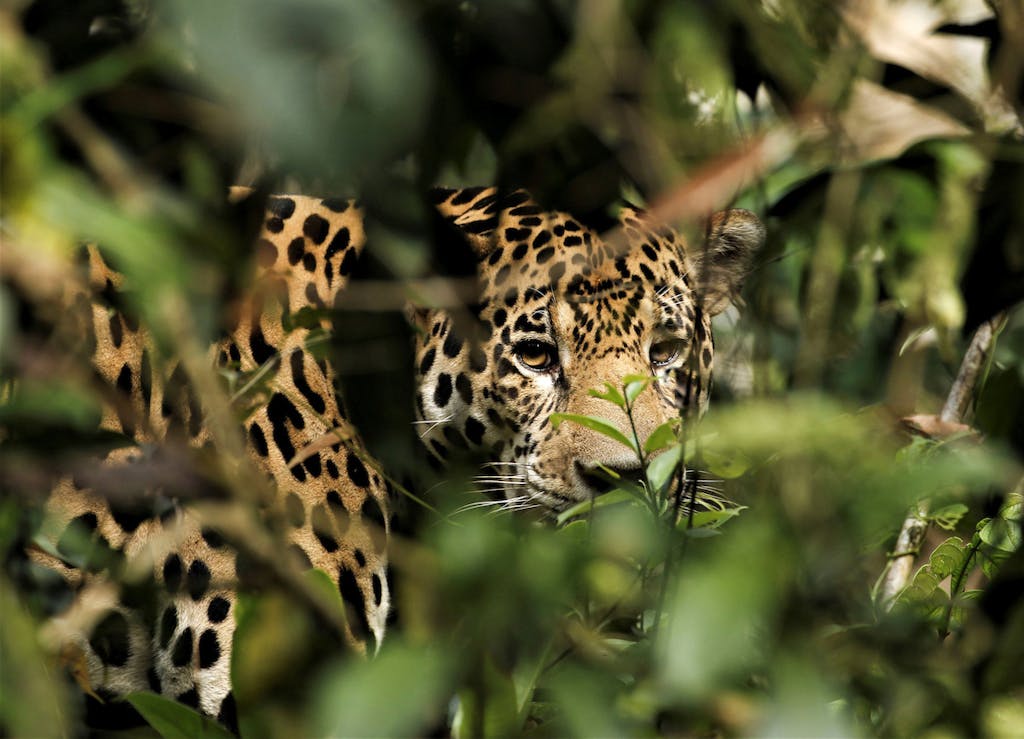
Animal lovers will swoon over the staggering number and variety of critters visible in South America. The Amazon rainforest alone, which covers 40 percent of the continent, shelters numerous species of insects, birds, mammals and reptiles, many still unrecorded by science. Head-swiveling standouts include anacondas, sloths, macaws, jaguars, capybaras, tapirs, monkeys, toucans and pink — yes, pink! — river dolphins.
Want to spot armadillos, guanacos, pumas and Chilean flamingos? Head to Patagonia’s windswept pampas and snow-capped mountains in southern Chile and Argentina. Long to see a majestic Andean condor and a woolly llama, alpaca or vicuña munching grass on a hilly slope? The Andes Mountains, the longest range in the world, is the place. If marine mammals and sea birds are your thing, Argentina’s Falkland Islands will oblige. There, you can check off 23 species of dolphins and whales and five species of penguins — more than a million in all.
Finally, pinch yourself if you make it to the 19 islands of Ecuador’s remote Galápagos archipelago to behold a panoply of eye-popping animals, many found nowhere else on earth. Marine iguanas, giant tortoises, Darwin’s finches, frigatebirds, Galápagos sea lions, flightless cormorants, blue-footed boobies and waved albatrosses all practically wave back at you, so unaccustomed are they to humans. South America is all this and more.
Choose Your Cruise:
Here’s an overview of the ports you may visit on a South American cruise. Silversea offers a variety of South America itineraries for both its expedition and classic ships. In the Galapagos, Silversea sails year-round on its new 100-guest Silver Origin, purposely designed and built for cruising in the archipelago. Other than the Galapagos, most itineraries focus on more than one country. And if you choose the Grand South America Voyage, you pretty much get to see them all.
Colombia and Ecuador

In a nutshell:
These two equatorial countries, once part of the colonial territory known as Nueva Granada, feature coastlines that include both the Caribbean and the Pacific. In fact, Colombia is the only South American country to frame both coasts. On a cruise, you may sample a wide range of experiences, including iconic cities, national parks and small ports. Urbanites will love the colonial splendor of historic Cartagena, Colombia, and the vibrant energy of sprawling Guayaquil, Ecuador. Wildlife lovers will thrill to the flora and fauna of Utría National Park and Gorgona National Natural Park, both in Colombia. And small-town fans will enjoy the coastal vibe in Puerto Lopez, Machala and Manta, Ecuador.
What you’ll see:
The undeniable queen of South America’s Caribbean, Cartagena is a fortified beauty, decked out with meticulously preserved buildings, swathed in eight miles of ancient stone walls and bathed in centuries of sunlight. Once the crown jewel of the Spanish Main, Cartagena oozes history from every street corner and bougainvillea-draped balcony, as befitting the primary port through which the riches of colonial Spain once poured. Stroll the cobblestone streets and alleys of Old Town, a UNESCO World Heritage Site. Clamber over the ramparts of the 16th-century San Felipe Castle that once kept Sir Francis Drake at bay. Explore the grisly Palace of the Inquisition, which displays the inquisitors’ instruments of torture, and the butter-yellow Cathedral and cool colonial convents. Loll on gorgeous beaches of bleach-white sand. Sway to the Afro-Colombian music pouring out of every open doorway and watch traditionally clad couples sashay to the cumbia, Colombia’s rhythmic national dance. And finally, bask in the sheer sensuality of one of the most romantic cities in the Americas — not surprisingly, the setting of Gabriel García Márquez’s novel Love in the Time of Cholera.
Sensations of another sort await in two natural settings: the tropical rainforest and mangroves of Utría National Park, one of the wettest areas on earth, and the subtropical forest and coral reefs of Gorgona National Natural Park. Tick off the species here, one by one: from sea turtles, dolphins and humpback whales to jaguars, spider monkeys and sloths to at least 13 species of snakes.
Perched on the Guayas River, Ecuador’s largest city and main port is also its commercial heartbeat. But Guayaquil’s swagger comes from its cultural assets, too. Keep your camera handy for the 400-year-old historic barrio of Las Peñas, where brightly colored wooden houses line cobbled, narrow streets. Then take in the iconic riverfront promenade, or malecón, more than 1.5 miles of gardens, playgrounds, monuments, restaurants, cultural venues and a shopping mall. Climb the 444 steps of Santa Ana Hill to reach its lighthouse and the reward of a show-stopping birds-eye view of the city. Learn about the city’s cultural and architectural traditions and ogle 45 species of birds, animals and reptiles in a semi-natural habitat at the Guayaquil Historical Park. Then stop for a bite or a drink amid tropical breezes at one of the restaurants, wine bars and outdoor cafes in Plaza Lagos, dotted with palm trees, bubbling fountains and an artificial lake.
The Ecuadorian coast is also the surprising birthplace of the Panama hat, which is made from the fiber of the toquilla palm. Tip your hat to Puerto Lopez, where you can swim, snorkel, dive or whale watch off its lovely bay, followed by a seafood meal drenched in coconut sauce. In Machala, which bills itself as the “Banana Capital of the World,” you can tour nearby mangroves or a unique petrified forest, visit quiet sandy beaches, and if you’re there in September, go bananas at the World Banana Fair. Say hello to the giant tuna statue that welcomes you to Manta, Ecuador’s second largest seaport and a hub for lively nightlife and great seafood dining (tuna ceviche, of course!).
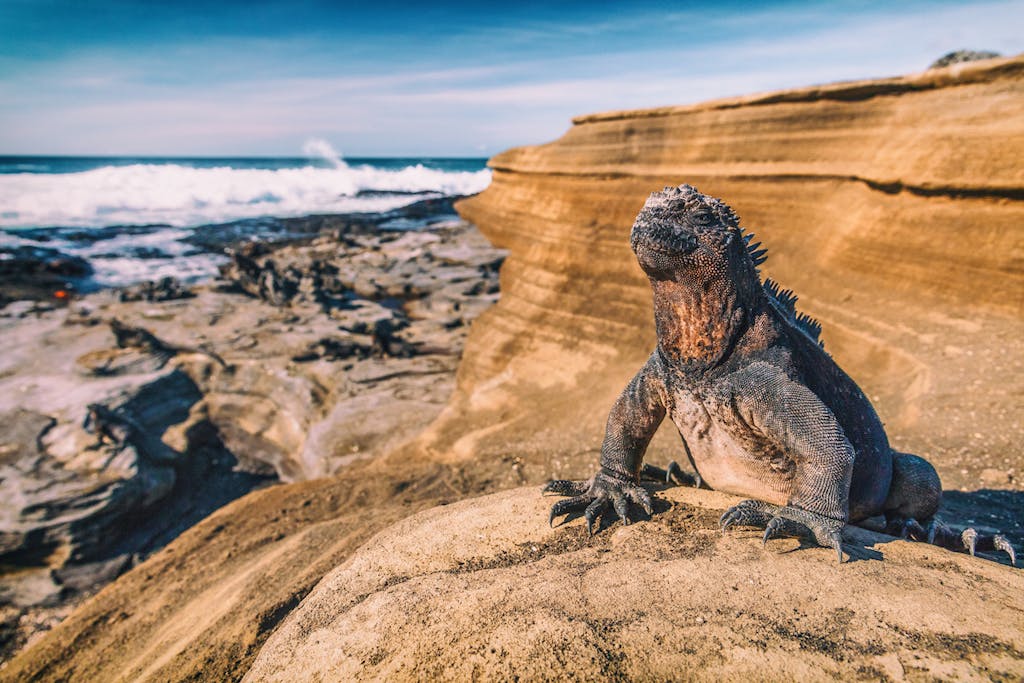
Finally, get ready for the ultimate bucket-list destination, Ecuador’s 19-island Galapagos archipelago. One of the remotest places on earth, and the first UNESCO World Heritage Site, it harbors eye-popping species found nowhere else. Come eyeball-to-eyeball with marine iguanas, giant tortoises, Galápagos sea lions, blue-footed boobies and waved albatrosses. Check off all 15 must-see species, delightfully unafraid of humans because of their isolation. Key to Charles Darwin’s theory of evolution, the animals here evolved to survive in the harsh, secluded habitat, almost 600 miles from the mainland in the Pacific Ocean.
Choose your cruise:
Expedition enthusiasts can sail the Galapagos Islands all-year around on Silversea’s new Silver Origin, a 100-passenger vessel that was purposely designed and built for the Galapagos.
Seven Silversea itineraries stop at ports in Colombia and Ecuador. Four visit Colombia and then transit the Panama Canal before heading down the Atlantic Coast of South America to visit Ecuador. Three others either start or end in Ecuador’s principal port of Guayaquil.
Peru and Chile
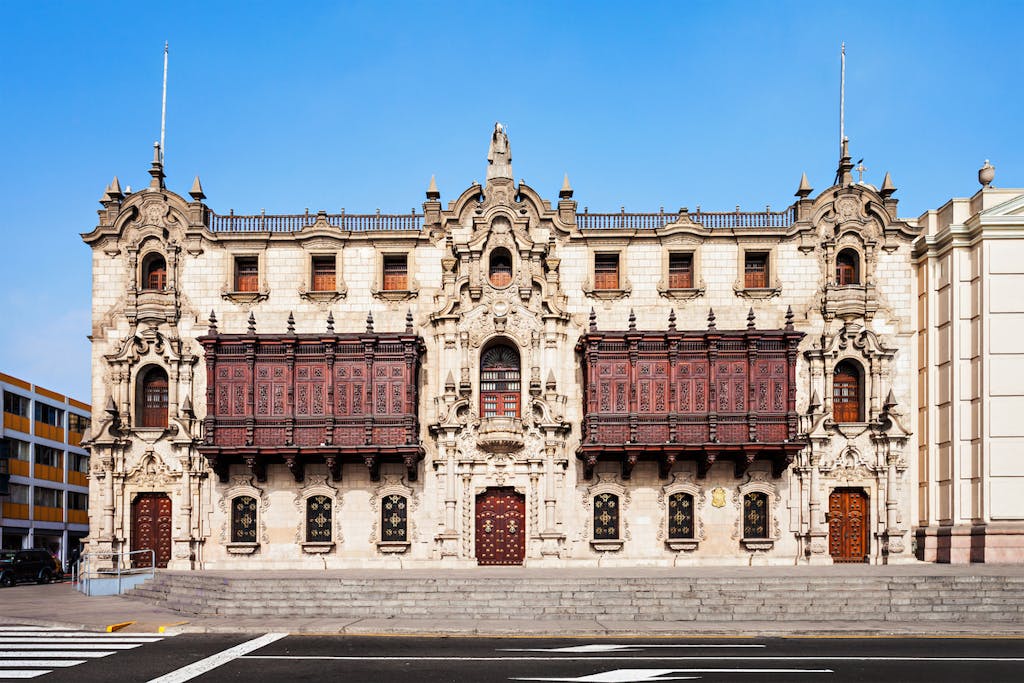
In a nutshell:
Along their combined 5,500 miles of coastline, these two countries have an astonishing range of features — from the remains of ancient cultures to the world’s driest nonpolar desert to dazzling glacier-littered fjords and teeming national parks to sophisticated modern cities. There’s enough variety and drama to fill anyone’s travelogue.
What you’ll see:
Archaeology takes center stage in Salaverry, Peru, as the base from which to explore the impressive ruins of the Moche and Chimú cultures: the Huaca del Sol y la Luna temples in nearby Trujillo, the relief-adorned Huaca del Dragón temple and Chan Chan, once one of the largest adobe cities in the world.
Layered with fascinating history and vibrant culture, Lima, Peru’s capital and largest city, is a sprawling metropolis of nearly 11 million people. Perched on a long cliff-lined coastline, the Spanish crown’s “City of Kings” was once the richest, most important city in the Americas. Glorious remnants of that era include colonial palaces, churches, and mansions clustered around centuries-old plazas. Check out such landmarks as the Cathedral of Lima containing Pizarro’s tomb, the Archbishop’s Palace with its ornate Moorish wooden balconies, the bright-yellow Municipal Palace, and the Baroque-style Government Palace, home to Peru’s president where you can watch the changing of the guard daily at noon. They vie with pre-Columbian temples, such as the pre-Inca mud-brick pyramid called Huaca Pucllana, for the attention of history buffs.
Lima may be known as the City of Kings, but it’s also a city of museums, including the National Museum of Archaeology, Anthropology and History of Peru; the Museum of Art of Lima; and the Museum of Contemporary Art of Lima. But Lima is also a modern, sophisticated metropolis, filled with edgy galleries, hip nightclubs, and avant-garde restaurants. In fact, dining out on some of the world’s most innovative and exciting cuisine, infused with the ingredients and traditions of Chinese, Japanese, African, and European immigrants, is an attraction in itself. Don’t miss marinated ceviche, washed down with a classic pisco sour, Peru’s national drink.
Fifty miles of gorgeous pristine beaches, a wildlife reserve teeming with animals, verdant vineyards and mysterious remnants of prehistoric cultures. The Peruvian area of Paracas has it all. Take a flight over the famous Nazca Lines that have bewildered scientists for more than a century. And explore the crown jewel, the Paracas National Reserve, an 828,000-acre refuge for 216 bird species, including migrating flamingoes and Andean condors; 19 types of mammals; and endangered Humboldt penguins, sea otters, orcas and other marine creatures.
The oldest mummies in the world and world-class surfing and beaches are the main claims to fame of Arica, located in the Atacama Desert and known as the “City of Eternal Spring.” Hike up El Morro rock to see reminders of the War of the Pacific in a military museum. And just south of town, gape at those Chinchorro mummies dating to a mind-boggling 5050 B.C.
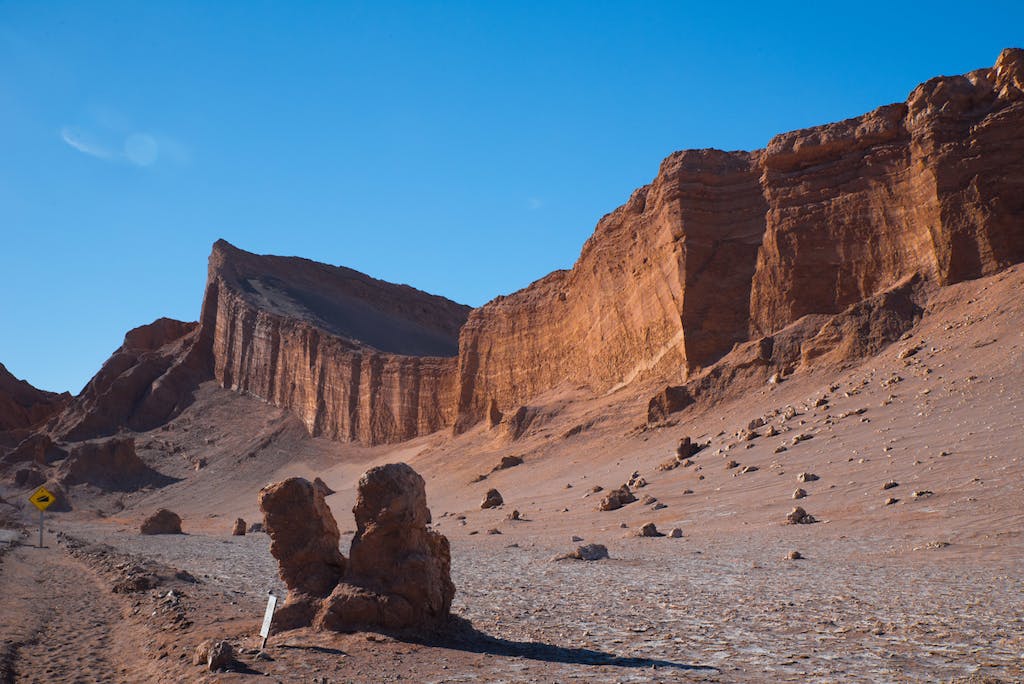
Two distinctive landmarks set the mining town of Antofagasta, Chile, apart: the Hand of the Desert, a 36-foot-tall sculpture of a hand emerging eerily from the desert floor, and La Portada, a natural stone arch arising from the ocean just offshore. The surrounding Atacama Desert, whose aridity ensures brilliantly clear skies, has turned the city into an international astronomy hub with several observatories for star gazing. Farther south on the uninhabited Isla Pan de Azúcar you can gaze at different kinds of stars: about 2,000 protected Humboldt penguins, as well as pelicans, petrels, otters and sea lions that can be viewed by Zodiac (landing is forbidden).
Coquimbo serves as the gateway to miles of quiet beaches; the popular resort town of La Serena, the second-oldest city in Chile (founded in 1544); the ancient petroglyphs of the Enchanted Valley; and vineyards in the Elqui Valley, whose grapes are used to produce Chile’s national drink, pisco sour.
Once home to Chile’s literary superstar and Nobel laureate, Pablo Neruda, Valparaíso is a colorful jumble of a city that has inspired poets, painters and musicians with its boho ambiance, quirky architecture and working-class vibe. You can climb the maze of steep, winding streets, lined with crumbling mansions, to visit Neruda’s hilltop home-cum-museum, La Sebastiana, just south of town. Sample the prized vintages at a world-famous Chilean winery in the Casablanca Valley. Back in town, pick up a souvenir at the Feria de Artesanía in Plaza Sotomayor. Watch the sailors and dockworkers at work along the gritty port. Enjoy the vibrant street art, nightlife and live music of a city bursting with creative energy. And for the ultimate in heart-in-your-throat views, climb aboard one of the rickety funicular “lifts” that link the lower town to residential neighborhoods in the hillsides. The vistas of the city haphazardly tumbling down to a wide bay are so worth it.
A small coastal resort at the mouth of the Valdivia River, Niebla played an oversized role in Chilean naval history with its fortifications against pirate attacks. Today, you can visit the 17th-century Niebla fort, relax on the area’s famed sandy beaches, and tuck into the freshest of seafood delicacies.
The capital of Chile’s scenic Lake District, Puerto Montt may be working-class unpolished, but it’s a standout dining spot for just-plucked seafood. Try specialties such as the paila marina seafood stew and the cancato (stew made of fish, chorizo, cheese and tomato). The city also boasts a rich German heritage, a legacy of settlers from 150 years ago, which is evident in the popular kuchen (cakes), local beer and gabled houses.
If Puerto Montt is a plain city, Castro is a vibrant showoff thanks to its candy-colored palafitos, or wooden stilt houses, that totter over the waterfront. Many now serve as restaurants, boutique hotels and artisan markets. Or thanks to its 70 or so wooden churches built in the 17th and 18th centuries, 16 of which boast UNESCO World Heritage status. The capital of the Chiloé Archipelago and Chile’s third-oldest city, founded in 1576, fuses modernity with the traditional seafaring culture of the Chiloé islands. Stop into the orange-and-lavender Church of San Francisco or the Regional Museum of Castro to admire the musical instruments, traditional farm implements and local-style wooden boat models and relics of the Huilliche indigenous people.
Remote and isolated, the tiny fishing village of Tortel is a mystical place cobbled together with wooden walkways, bridges and stairs that connect the houses and piers that line the cove. Surrounded by the spectacular San Rafael Laguna National Park and tucked between the Northern and Southern Patagonian ice fields, it offers access to snow-topped Andean peaks, sparkling lakes, sprawling forests and dramatic glaciers.
Because of those glaciers, Southern Chile is laced with dazzling fjords and channels in a landscape full of drama. Cruises sail through the English Narrows, a slender passage surrounded by Chile’s largest national park, Bernardo O’Higgins National Park; the Pio XI Glacier, South America’s longest glacier; and the Garibaldi Fjord and Glacier, which slices through tumbling waterfalls, dense forests and soaring mountains. Keep your eyes open and your camera at the ready for Andean condors, fur seals, sea lions, dolphins and humpback whales.
Chile’s gateway to Antarctica, Punta Arenas is a sprawling frigid city on the edge of the Strait of Magellan. Anchored by the Plaza de Armas with its famed Statue of the Indian (touching its toe means you’ll be back), this remote metropolis offers a refuge from such wild wonders as the Alberto de Agostini National Park’s glacial sculptures; the Torres del Paine National Park; and the birdlife sanctuary of Magdalena Island.
Choose Your Cruise: Silversea offers both expedition and classic cruises calling at Peruvian and Chilean ports, often part of itineraries that call at other South American countries as well. One particularly intriguing option is a 25-day Pacific Coast voyage between Peru’s Guayaquil and Argentina’s Ushuaia.
Argentina and Uruguay
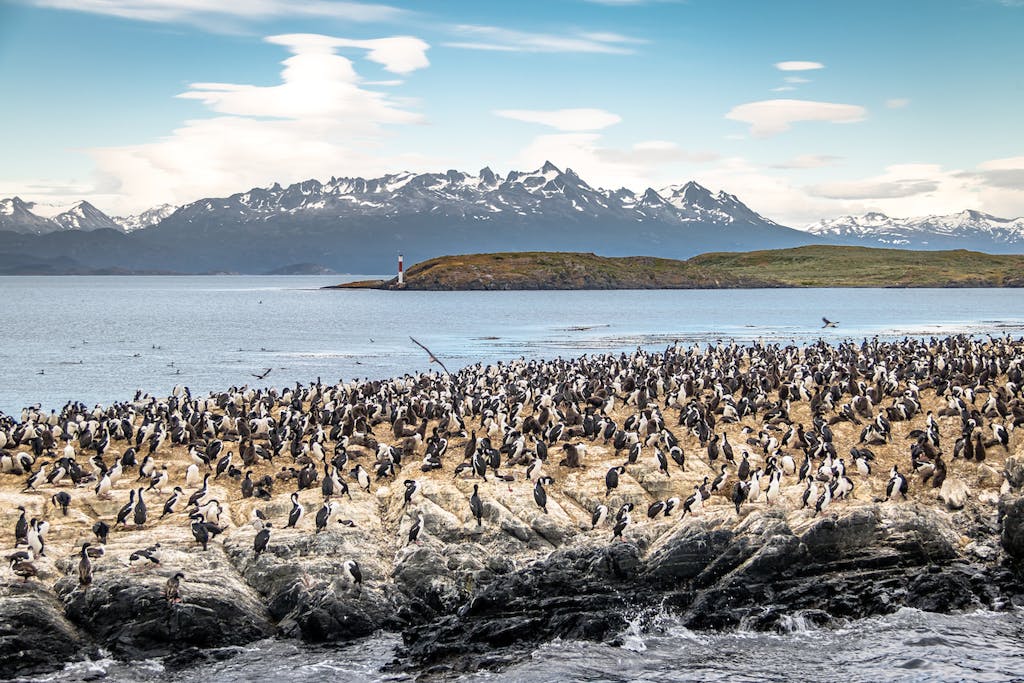
In a nutshell:
Wrapped around the continent’s “southern cone,” Argentina and Uruguay maintain the strongest European heritage of South America’s nations. Want cosmopolitan sophistication? Visit the capitals of Buenos Aires and Montevideo. Long to relax at a beachside resort? Chill in Uruguay’s tony Punta del Este. Hankering for adventure? Check out the frontier town of Ushuaia, Argentina, and the wildlife-rich Falkland Islands.
What you’ll see:
The planet’s southernmost city, end-of-the-world Ushuaia, Argentina, is a lively little port where the jagged snowcapped Martial Mountains, part of the Andes range, screech to a halt at the famous Beagle Channel. Along with being the gateway for 90 percent of all Antarctica-bound cruises, it’s an adventure hub for hiking, skiing, sailing and kayaking in Tierra del Fuego National Park. Local duty-free businesses, which cater to fleece- and down-jacketed explorers, aren’t shy about their end-of-the-world bragging rights — from the End of the Earth Museum to the World’s End gift shop. And cozy restaurants serve local specialties: king crab and lamb, which thrive in the cold waters and mountain slopes here.
Two stops in the wind-lashed British Falkland Islands — Port Stanley and West Point Island — let you get up close and personal with some of their millions of penguins (the Falklands are considered the penguin capital of the world) and a huge colony of black-browed albatross. More remarkable wildlife —from Commerson’s dolphins to Magellanic penguins to breeching whales — awaits in Puerto Deseado, Camarones and Puerto Madryn in Argentina’s wild Patagonia region, which impressed even Darwin.
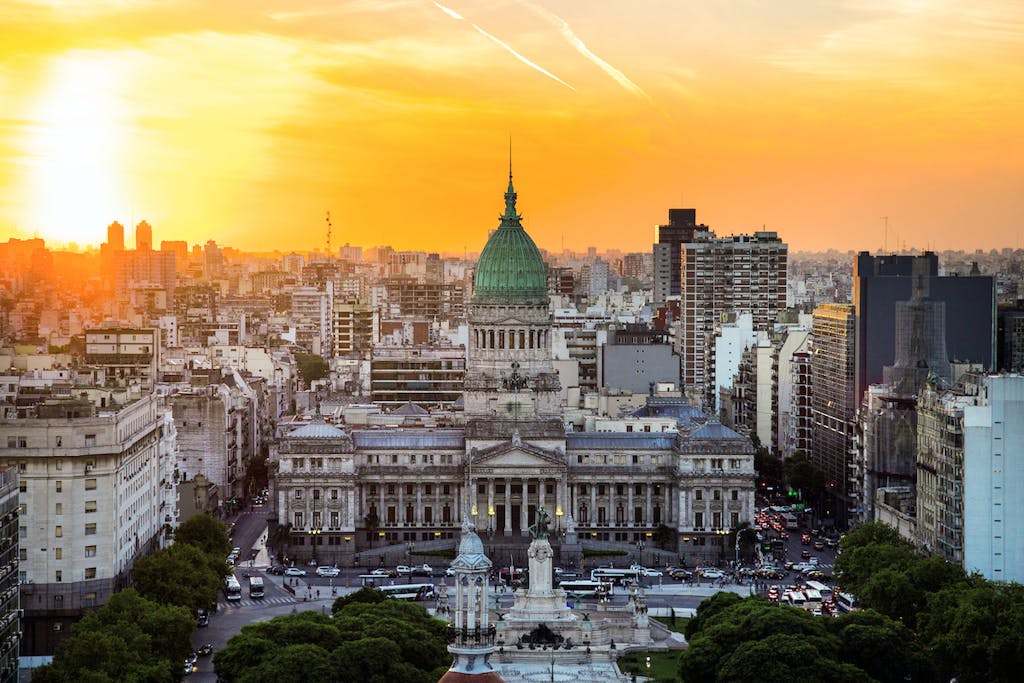
One of the world’s most sophisticated cities, Buenos Aires teems with stylish restaurants, glamorous bars, historic cafes and pulsing nightclubs. Head out on 9 de Julio Avenue, the widest avenue in the world, to spot such city icons as the obelisk, a Washington Monument lookalike, and the landmark Colon Theatre opera house. Resembling the grand capitals of Europe, this is a city of leafy parks, tree-lined boulevards and monuments — 6,000 of them! At once cultured and earthy, prosperous and gritty, the city is known for its neighborhoods — from cafe-laden Palermo to upscale Puerto Madero, whose old brick riverfront warehouses have been reborn as tony restaurants, shops and condos, to the bohemian La Boca in the vibrant La Plata River port area, a riotous jumble of cafes, bars and shops in loud Crayola colors. Crooning buskers, stylized tango dancers and street vendors and artists all vie for your attention.
Don’t miss La Recoleta Cemetery, the burial site of the nation’s beloved first lady, Evita Perón. Or the stately Plaza de Mayo, site of the rose-hued Casa Rosada presidential mansion, from whose balconies Evita famously addressed her adoring throngs. Nearby are the Metropolitan Cathedral, where native son Pope Francis once served as archbishop, and the National Museum of Fine Art housing the largest collection of public art in Latin America. And finally, don’t bypass a perfectly grilled Argentine steak in a parrilla, washed down by a full-bodied Malbec, of course.
The St. Tropez of South America, Punta del Este is a sun-kissed beach resort favored by the Uruguayan and Argentine jet set. They flock to its bars and seaside restaurants to feast on freshly caught seafood while watching the sleek yachts bobbing at harbor.
Home to half of Uruguay’s population, Montevideo is a lively eclectic city encompassing an industrial port, a historic downtown and exclusive beachside enclaves. Gorgeous colonial and Art Deco architecture competes with modern skyscrapers in this capital across the La Plata River from Buenos Aires. The performing and fine arts thrive here in venues from elegant older theaters and cozy little tango bars to beachfront discos and hip galleries. Stroll the long waterfront walkway, La Rambla, and relax on a bench to gaze out to sea. Check out Plaza Independencia to admire the statue and mausoleum to José Artigas, father of national independence in 1825, and the landmark Salvo Palace. And feast on a fire-seared steak at one of the bustling parrillas in the Mercado del Puerto old port market.
Choose your cruise: Of the numerous Silversea itineraries that visit Argentina, they all either start or end in Ushuaia or Buenos Aires. Three of them include stops in Uruguay.
Brazil
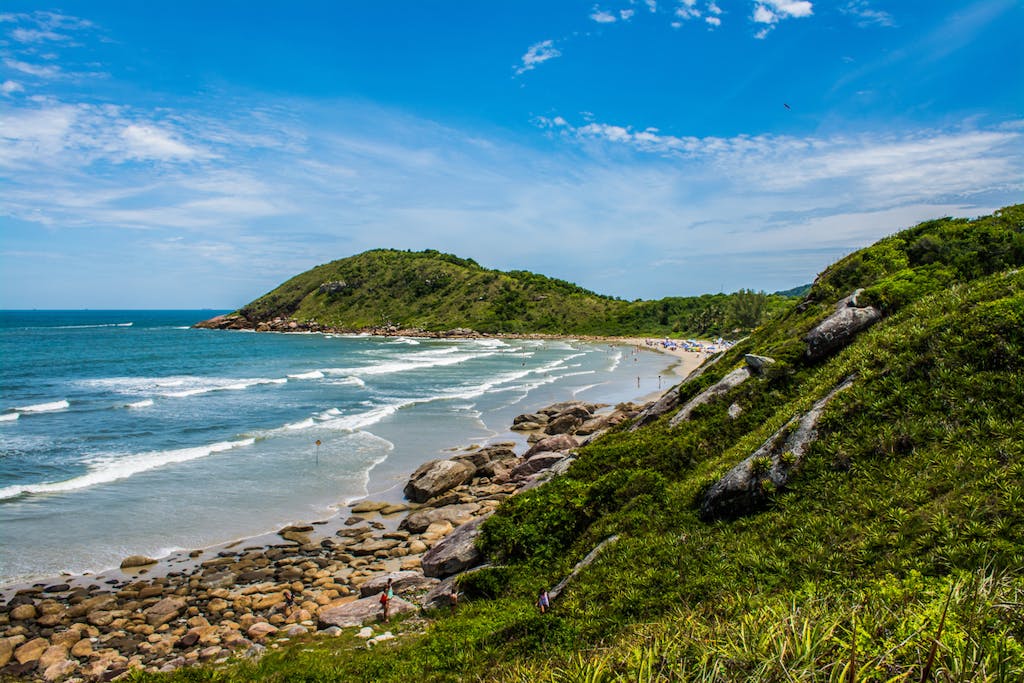
In a nutshell:
South America’s largest nation, and its only country settled by the Portuguese, goes to extremes — from primordial jungles and thundering waterfalls to powerful rivers and dazzling white beaches to pretty colonial towns and cutting-edge cities. Overlaying it all is the effervescence of carnivals and fiestas, of samba and bossa nova, of candombe and a passion for soccer that is more religion than sport.
What you’ll see:
In Brazil’s southernmost state of Rio Grande do Sul, steeped in cattle herding and gaucho culture, the eponymously named city sports historic 18th-century buildings and what’s considered the longest beach in the world, the 150-mile-long Praia do Cassino Beach. Note the locals using a straw in a gourd to suck up chimarrão, the region’s distinctive tea made from the yerba maté plant.
A popular beach town, Porto Belo wears the legacy of its Azorean and German immigrants with pride. You can enjoy Azorean cuisine, festivals and architecture and tuck into classic German sausages paired with locally brewed beer. Meanwhile, near Paranaguá you can boat along the waterways that snake through the flora- and fauna-rich forests and national parks in the area. If walking is more your style, the Ilha de Anchieta features several hikes through Anchieta State Park, such as the Saco Grande Trail, the Praia do Sul Trail and the Represa Trail. Keep an eye out for tree-hugging orchids and bromeliads.
Get your beach fix in Itajai, where beach worship is so important it has the world’s only cable car to connect two strands. And get your history fix in Paraty, a pretty-as-a-picture, cobblestoned town with colorful 18th-century architecture.
Meaning “beautiful isle” in Portuguese, Ilhabela lives up to its name with its splendid beaches, UNESCO Biosphere Reserve and 360 — count ‘em — waterfalls.
With its lushly forested mountains and shimmering beaches defining a heart-stopping setting, it’s no wonder Rio de Janeiro is called the Cidade Maravilhosa, or Marvelous City. Just take the legendary beaches of Copacabana and Ipanema, which define endless fun in the sun and people watching as a way of life. Keeping careful watch over it all is the iconic Art Deco statue of Christ the Redeemer, crowning the summit of Mount Corcovado. Similarly, Sugarloaf Mountain, reachable by its famous cable car, stands guard over Brazil’s second-largest city, too. Rio pulses to the beat of sultry samba, from its live music halls in the bohemian Lapa neighborhood to its all-night parades to its annual world-famous Carnival. And it worships at the altar of soccer, where matches fire up cariocas like nothing else. After attending a competition at the Maracaña Stadium, celebrate with a feijoada stew accompanied by a fiery caipirinha, Brazil’s national cocktail.
A mere two-hour drive from Rio, Búzios perches on a peninsula blessed with 17 glorious beaches. Affixed to the international tourist map by Brigitte Bardot in the early ‘60s, Búzios maintains its St. Tropez image with upscale resorts, boutiques, restaurants and bars along its narrow cobblestone streets and scenic waterfront.
History, on the other hand, is alive and well in Porto Seguro, the first landing spot for Portuguese explorer Pedro Álvares Cabral in 1500. Claiming to be Brazil’s birthplace, the oldest town in the country has a small historic center with restored colonial houses and churches. A different kind of history defines Ilheus, which served as a prosperous cocoa port during Brazil’s cocoa-producing heyday. Showy Baroque and Gothic buildings remain from that golden age, some of which turn up in the novels of native son, Jorge Amado: Gabriela, Clove and Cinnamon and Dona Flor and Her Two Husbands.
Embrace Brazil’s thriving and vibrant Afro-Brazilian culture in Salvador de Bahia, the onetime capital of Portugal’s New World colony. Sway to the rhythms of samba music, candombe drum ceremonies and capoeira martial art displays pulsing through this living museum of cobblestoned streets, multi-colored 17th– and 18th-century architecture and gold-encrusted churches. Join one of the frequent street festivals, including the granddaddy of them all, Carnival, celebrated in authentic Salvador style. And indulge in the local specialty, moqueca, a creamy fish stew made with coconut milk, peppers and chiles.
Sweeping beaches and dramatic sand dunes (yes, you can take a buggy ride) are the primary draws of Natal, capital of the state of Rio Grande do Norte. Meanwhile, one of Brazil’s longest and best urban beaches and a social hotspot awaits in Recife, a sprawling modern city in Brazil’s Northeast. Named for the offshore recifes, or reefs, that break the incoming waves, Recife hops to its own Carnival and lively dining and nightlife. Its lacy canal network has spawned the nickname, Venice of Brazil. Near Recife — a perfect day tour — is the enchanting hilltop town of Olinda, whose historic city center features Portuguese influences who originally settled here. Also, unusually, you’ll see some Dutch influences, such as Delft tiles used in its historic churches; the Dutch captured the city though the Portuguese ultimately won it back. Olinda is on UNESCO’s list of World Heritage Cities.
More golden sands mark Fortaleza, also known as the “City of Light” for its endless Brazilian sun. One of the country’s biggest cities is also one of its best party towns with a spirited forró music and dance scene. For a quieter throwback experience, stroll among the candy-colored colonial buildings or into the Dragão do Mar Cultural Center, an arts venue with a theater, cinema and planetarium.
The eastern gateway to the Amazon River, modern Belém retains its European colonial charm in the traditional blue tile and pastel façades of its grand mansions and churches, a reflection of Lisbon’s 17th-century architecture. To get a feel for the Amazon’s amazing cornucopia, visit the four-block-long Ver-o-Peso Market — quite possibly the largest outdoor market in Brazil. In addition to the pungent produce and freshwater fish, you can pick up a good luck charm associated with macumba, a local folk religion with African roots.

As Silversea navigates the mighty Amazon, the largest river in the world by discharge volume of water, it visits a string of interesting riverside ports right in the heart of the Amazon rainforest, the world’s richest and most-varied biological reservoir. First up is Guajara, a backwater town where the traditional community harvests the açaí palm, source of the nutrient-rich berries that have become the latest health-food darling. Farther on, explore the floodplains of Rio Balaio via Zodiac and watch for flying parrots, squirrel and howler monkeys, Jabiru storks and horned screamer birds. Ever longed to see a sleek pink river dolphin in its natural setting? Furo dos Botos, or hole of the river dolphins, is the place. While checking out the “flooded forest” here, you may also spot monkeys, sloths, big-billed toucans, and a variety of other birds.
One of Brazil’s oldest settlements, dating to 1621, Santarém offers a taste of rainforest culture. Perched 500 miles upriver from the Atlantic, this languid river town boasts a waterfront promenade, some good restaurants and the Sacred Arts Museum whose 1,000 pieces span four centuries. The panoply of rainforest flora and fauna beckons in the nearby Tapajós National Forest, including protected species such as white-bellied spider monkeys, giant anteaters, jaguars and giant armadillo. More local culture can be experienced in the village of Paritins, which celebrates the Boi-Bumba folkloric festival each June, one of the largest fests in the country. Silversea arranges a special performance for guests. And in Boca da Valeria, a collection of thatched huts on stilts, you can visit villagers’ homes to glimpse their traditional way of life.
An opera house in the middle of the jungle? Yup, that eye-rubbing incongruity sets Manaus, the Amazon’s largest city, apart. The ornate Renaissance-style Amazonas Theatre was built during Manaus’s 19th-century rubber boom, like many of the city’s other grand buildings. Today, this gritty, bustling shipping port also draws visitors for its unique location at the famous Meeting of the Waters. Just outside town, the dark tannin-rich water of the Rio Negro merges with the milky water of the Rio Solimões to form the Amazon, creating a dramatic sight.
Speaking of sights, get ready to fill your Insta-feed with the world’s largest water lilies, called Victoria amazónica, at Lago Canaraci, whose quiet waters allow the plants to flourish. The 8-foot-wide lily pads, which resemble oversized pastry tarts with their upturned rims, can support the weight of a child. Birds sometimes alight on these floating platforms.
Be prepared for 50 shades of green along Furo Comprido, an Amazon side channel meaning Long Hole. You can spot brilliantly colored parrots, macaws, tanagers and manakins huddled in all that verdant foliage. Locals who live along the river, a mix of European, Indian and African ancestry, call themselves cabocles. More of the region’s diverse wildlife lines another side river, the Curuá Una. Here, you can search for black and spectacled caimans during a night excursion. In isolated Jariuba, check out the dazzling orchids and other epiphytes clinging to trees, Lilliputian hummingbirds flitting about, and turtles, caimans and otters in the water.
Finally, along the Rio Cajari, an Amazon tributary at the delta, you’ll encounter people who live in stilt houses connected by walkways. To survive, they hunt large rodents like paca and agouti, fish for river species, and collect Brazil nuts and palm fruit from the forest.
Choose your cruise: Rio de Janeiro (along with Buenos Aires) is a pivotal marquee port for Atlantic-based itineraries in South America, connecting travelers to the Amazon River as well.
Guianas

In a nutshell:
A trio of tiny countries well off the beaten path — French Guiana, Suriname and Guyana — stand apart from the rest of South America for their French, Dutch and British colonial heritages, respectively. Thanks to these cultural influences, you can watch old timers play the quintessential French game of boule; meet Saramaka-speaking Maroons, descendants of escaped slaves from Dutch colonial plantations; and admire ornate Anglican churches and 19th-century homes with boxed demerara windows. Nature’s exuberance runs like a through line in all three, showing off its astonishing tropical flora and fauna at every turn.
What you’ll see:
A onetime brutal penal colony just seven miles offshore from French Guiana, Íle Royale is one of three ironically named Salvation Islands where France once sent its political prisoners. Neighboring Devil’s Island was the setting for the autobiographical novel and famous Steve McQueen movie, Papillon. The soft sands and gently waving palms that greet people today belie that ugly past. As the administrative headquarters of the penal settlement, Íle Royale has several restored prison buildings, including a hospital, staff quarters, a prisoner-built chapel and a restaurant-guesthouse where you can eat lunch and even spend the night.
It may be South America’s smallest country, but Suriname (formerly Dutch Guiana) is big is with cultural diversity. Take the capital of Paramaribo, whose UNESCO World Heritage-listed downtown oozes Dutch colonial charm in its nearly 300 17th– and 18th-century wooden buildings. But its mélange of languages and cuisines also reflects the descendants of British colonialists; Indian, Indonesian and Chinese indentured laborers; escaped African slaves; and indigenous Amerindians. Just a few hours away by road or river boat, the untamed jungle beckons with colorful birds, monkeys, agoutis, jaguars and dolphins. That’s where descendants of Maroons still live in communities that carry on the traditions of their African ancestors.

Georgetown, Guyana’s languid capital, may be British by lineage, but its soul is loyal to the West Indies. Reggae beats fill the air, Caribbean bakes and saltfish are served for breakfast, and island-style festivals and jump-ups, propelled by steel pans, dot the calendar. Still, the city’s British colonial architecture stands tall, especially the painted-timber Gothic-style St. George’s Anglican Cathedral. Two other landmarks, the iron-and-steel Stabroek Market and wooden Bourda Market, are frenetic emporiums selling everything from fresh produce and jungle medicine to jewelry, electronics and shoes.
An Amerindian word meaning “Land of Many Waters” for its abundance of fresh water, Guyana counts three large rivers, including Essequibo River, among its distinctive features. This vital transport waterway slices through an interior that is very Amazonian, with its Amerindian river communities and spectacular wildlife. Covering 75% of its territory, Guyana’s primeval rainforest features abundant waterfalls — including Kaieteur Falls, the largest single-drop cascade in the world — and species ranging from showy Guianan cock-of-the-rock birds to jaguars, the country’s national animal and just one of its six wild cat species, including ocelots, pumas, jaguarundi, margay and oncilla.
Choose your cruise: Three Silversea itineraries visit at least one of the three Guianas. All three cruises depart from ports in Brazil, from Manaus to Fortaleza to Rio de Janeiro. The Guianas are also part of Silversea’s South American Grand Voyage.
